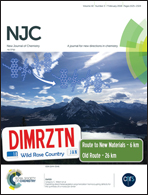Probing the factors that influence the conformation of a guanidinato ligand in [(η5-C5Me5)M(NN)X] (NN = chelating N,N′,N′′-tri(o-substituted aryl)guanidinate(1−); X = chloro, azido and triazolato)†
Abstract
Three types of half sandwich complexes, namely, [(η5-Cp*)M(NN)X] (Cp* = C5Me5; NN = chelating N,N′,N′′-tri(o-substituted aryl)guanidinate(1−) ligand; M = Rh/Ir; X = Cl (9–13), N3 (14–18) and N3C2(C(O)OR)2 (19–21)), were prepared and isolated in moderate to good yields. The new complexes were fully characterized and further molecular structures of key complexes from each type were determined by single crystal X-ray diffraction (SCXRD). The new complexes revealed syn–syn (10, 12, 15 and 20), anti–anti (13 and 16) and anti–syn (14, 17, 19·CHCl3 and 21) conformations. DFT calculations were performed on four conformers of 14, which revealed the stability order as syn–syn (0.00 kcal mol−1) < anti–syn (0.23 kcal mol−1) ≪ syn–anti (3.15 kcal mol−1) ≪ anti–anti (5.15 kcal mol−1). An intra-ligand repulsive interaction between the o-substituent in two proximal aryl rings in guanidinate ligands of 14 and 17 was invoked as a driving force for the observance of the anti–syn conformer in the solid state, which is likely formed from a hypothetical syn–syn conformer via a guanidine centered rearrangement. The influence of packing forces upon the anti–syn conformation of the guanidinate ligand in 14 was also discussed. NBO analysis was carried out on the N3 moiety of the syn–syn conformer of 14 in order to identify the likely resonance form responsible for [3+2] cycloaddition with the alkyne. Several new complexes that contain an o-substituted arylguanidinate ligand were shown to exist as a mixture of conformers in solution as revealed by NMR spectroscopy, and these conformers were shown to arise from a solid state conformer via guanidinine centered rearrangement.
![Graphical abstract: Probing the factors that influence the conformation of a guanidinato ligand in [(η5-C5Me5)M(NN)X] (NN = chelating N,N′,N′′-tri(o-substituted aryl)guanidinate(1−); X = chloro, azido and triazolato)](/en/Image/Get?imageInfo.ImageType=GA&imageInfo.ImageIdentifier.ManuscriptID=C7NJ03766J&imageInfo.ImageIdentifier.Year=2018)


 Please wait while we load your content...
Please wait while we load your content...